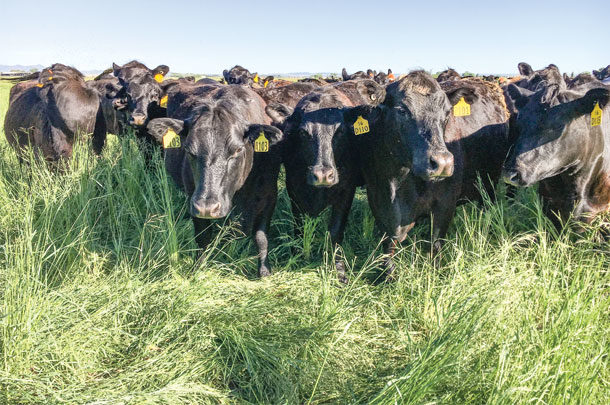Many farmers and ranchers are considering MiG as an option due to the pressure to reduce public land grazing and the declining space available for pasture. Adoption of this practice has the potential to bring the benefits of intensively managed, improved pastures into the already established irrigated crop infrastructure that exists on many ranches.
However, there are still many unknowns about the implications of an intensive cattle grazing system on a limited parcel of irrigated land. These interests spurred the development of a long-term, irrigated management-intensive grazing project to evaluate the biological and economic processes related to soils, plants, water and livestock.
In 2017, this project was launched at Colorado State University’s Agriculture Research, Development and Education Center (ARDEC). The project takes place on a 200-acre irrigated pivot planted with four different cool-season grass and grass-legume mixtures. In addition to research, this project currently provides 100% of the feed for the cow herd (approximately 150 cow-calf pairs) from May through October.
The irrigated cool-season forage base provides an extremely high-quality diet for the herd as well.
The forage on the pivot has been consistently producing crude protein levels upwards of 20%. This system has also allowed for greater accessibly and monitoring of cattle health.
Prior to the establishment of this project, cattle were being shipped to high-elevation pastures to graze for the duration of the growing and calving season. This made cattle simply inaccessible for research and educational purposes as well as general herd monitoring.
Calf survival rates were suffering because monitoring herd health was not an option. Within the MiG project, cattle are moved to a new pasture daily, which allows for close monitoring of health and quick access to facilities for treatment. In general, a more intimate knowledge of the herd is being built due to accessibility and daily involvement with the animals.
From an operational standpoint, MiG has shown to have many benefits. However, ecologically, much less is known. A large part of the research for this project is geared towards understanding MiG’s impacts on soil health. Studying changes in soil health is integral for improving our understanding of how MiG affects the overall function and viability of cropland converted to pasture grazing systems.
To quantify short-term changes in soil health, extensive soil sampling and analysis was completed prior to grazing and one year post grazing. To compare pre and post grazing, we utilized a program called the Soil Management Assessment Framework (SMAF). Results from 11 soil health analyses (soil texture, bulk density, water-stable aggregates, pH, electrical conductivity, phosphorous, potassium, potentially mineralizable nitrogen, microbial and enzymatic assays and soil organic carbon) were input into the program along with the soil’s inherent properties, climatic conditions, crops present and management practices performed.
These variables are considered within the SMAF to create an output that reflects the specific limitations and needs of the analyzed soil. These details allow output values to be relative to input values, allowing the program to be transferable across climates and locations. This program has been used similarly in previous research to measure soil health changes in native pasture, perennial vegetation systems and cropland converted to pasture.
Results
Results from our research showed that physical, biological and nutrient soil health categories significantly responded to grazing and management changes from tilled, irrigated row crops to an irrigated perennial grazing system. Positive effects were observed with increases in soil biological activity, in particular, increases in microbial and enzymatic activities, which are early indicators of future carbon sequestration.
Soil organic carbon remained relatively unchanged but will be an important indicator to monitor over the long term due to its relationship to many other soil functions. Negative impacts occurred to the soil’s physical properties, driven primarily by increasing bulk density. This result was likely caused by initial hoof compression during grazing. At a certain threshold (approximately 1.7 grams per cubic centimeter), bulk density can impede root growth, soil hydrology and ultimately forage yield.
Unfortunately, mechanical methods of alleviating increased levels of bulk density (compaction) have not proven to be very effective in pasture systems. Therefore, the best approach is to mitigate potential increases in bulk density with proper grazing management, especially not grazing on heavier textured soils when they are wet.
Phosphorus and potassium levels would be expected to increase over time due to recycling of nutrients in manure and urine. However, levels of phosphorus declined while potassium increased. Phosphorus is excreted primarily in the manure while potassium is excreted in the urine. Urine covers approximately three times the area compared to manure, so you are more likely to measure short-term increases in potassium than phosphorus. Over time, you should see an increase in phosphorus levels and a decreased need for fertilization.
Although these are only initial findings, it is essential to continue monitoring this grazing system over the long term to gain an understanding of how MiG can promote and sustain soil health.
The results of current and future soil health data do not necessarily determine the success or failure of this grazing system, but do provide guidance for making future management decisions and recommendations. Management-intensive is hyphenated because the system is not “intensive grazing” but “intensive management.” MiG requires constant assessment and adaptation in management based on new information.
Because this is the beginning of a long-term project, there is a steep learning curve in understanding how to recognize key elements, make decisions and trouble-shoot issues. Over time, in theory, management of the cattle and forage should improve, ultimately improving the overall health of the system. Ultimately, I find myself wondering, is “How will MiG impact soil resources” the right question? In my opinion, the question should truly be, “How can we manage to drive a positive outcome regarding soil resources?” ![]()
PHOTO: Many farmers and ranchers are considering MiG as an option due to the pressure to reduce public land grazing and the declining space available for pasture. Photo provided by Joe Brummer.
Joe Brummer is an associate professor and extension forage specialist in the department of soil and crop science at Colorado State University. Email Joe Brummer.

-
Casey Shawver
- Former Graduate Student
- Colorado State University
- Email Casey Shawver











